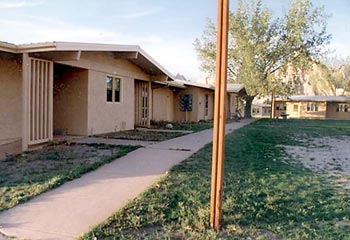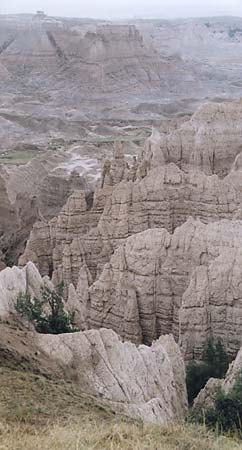FROM THE BADLANDS
It's 9 in the morning and I'm wedged in a crevice, my feet braced on the wall in front of me, my watercolor pad close to my face. A fine salty dust is carried in with each rush of wind through the narrow drainage and begins to dull the colors of my paints and make my eyes water. Bits of hardened clay drop from above, one nestles in my watercolor box. I hope it's still there when I get back to Rhode Island to remind me of living for a month in the South Dakota badlands.

The formations of the Badlands surround me even as I kick off my mud-encrusted boots outside my front door; so as not to dirty the shag wall-to-wall carpet in apartment 52D, ranger housing I am given in park headquarters. Once inside all I can see from the big front window is a bare courtyard and another of the four low buildings that make up the "Quad". From the small windows in my kitchen I can, from a certain angle, peek out at the sun going down behind the jagged turrets of the 300 foot prairie drop called the Badlands wall. You could say this apartment lacks charm, furnished in mustard colored Naugahyde and particleboard, but it allows me to live within the park, in the middle of this incredible landscape, and for that I am very grateful to be chosen by the National Park System as an artist-in-residence. This will be my home for a month and I know I will soon find it welcoming when I return tired and hungry each evening and tack more drawings to the stark white walls, as the stars fill the big sky and are drowned out by the floodlights in the courtyard. by the National Park System as an artist-in-residence. This will be my home for a month and I know I will soon find it welcoming when I return tired and hungry each evening and tack more drawings to the stark white walls, as the stars fill the big sky and are drowned out by the floodlights in the courtyard by the National Park System as an artist-in-residence. This will be my home for a month and I know I will soon find it welcoming when I return tired and hungry each evening and tack more drawings to the stark white walls, as the stars fill the big sky and are drowned out by the floodlights in the courtyardby the National Park System as an artist-in-residence. This will be my home for a month and I know I will soon find it welcoming when I return tired and hungry each evening and tack more drawings

I am given the use of a government car to travel within the park, and find the car radio picks up the signal from the Pine Ridge reservation—KILI, the voice of the Lakota Nation. It also has a two-way radio, and at first the abrupt interruptions of the rangers’ workday communications make me jump. Long as the road is at 22 miles, every trip is a revelation and I never tire of the rolling drive with its long climbing curves, hit-the-brakes-beautiful light effects, the sound of gravel beneath my tires.

John and I spend our first day on the south road, getting out at every overlook, some which look down on an endless maze of huge sand castles, others open up to the sky and out to the horizon where the clouds are like continents, changing the prairie below as they move in from the west. The second day we rise early and head north, stopping to hike all the short trails, the Door, The Window and The Notch. Then the morning, which had been so fine, with high winds and threatening skies, settled into a cold drizzly rain. But we still venture out with a ranger to Sheep Mountain Table in a huge Chevy Suburban that climbs like a tank up the heavily rutted road to the top of the plateau.
The flat summit has a somber feel in the chill of misty grayness. We walk to the edge as far as we dare, past where the prairie grass ends and along the spine of the pinnacles which fall away on either side. They rise again in the distance—immense columns resembling shrouded white figures, leaning into each other, their murmured conversations lost in the rain. In some places Juniper trees cling to the edge, prayer bundles dangling from their branches. There are those who climb to Sheep Mountain Table to make these offerings, some come up to drink, sometimes losing track of the edge and tumbling from the flatness.
Standing on a hot, windy hillock I feel the moisture blown from my body and I begin to worry about running out of water. I picture the extra canteen left, for no good reason, in the trunk of the car, more than an hour's hike back over the prairie. I take a small sip from my half-full canteen and John and I decide to press on. Water becomes part of a pattern of thoughts and footsteps as my boots weave through needle grass, dry platters of buffalo chips and lethal low-lying cactus. A snake, almost stepped on, sends John leaping straight up, and sprinting back towards me. We gingerly approach and examine it, but although large and mud colored, it is not a rattlesnake. I won’t encounter that creature for a few weeks yet.

Resuming my walking meditation my mind turns to the homesteaders who tried to sustain themselves on this land in the early 1900s. Did the prairie creep into their dreams, like the dust that found every crack in their defenses, and finally pushed them back in the relentless drought and dust storms of the 1930’s? I look back for the Cottonwood tree that stood like a beacon upon a rise and whose windblown leaves made a sound like a heavy rain. But it is hidden now by the rolling terrain. We cross Sage Creek where it dips and fills with grass so thick that it hides the shallow water. When we climb up the opposite bank the terrain is more fractured. Slabs of prairie form small plateaus, spiny discs of cactus tumbling over their flat tops, textured and complicated above the fluid whiteness of the eroded earth which spills like an apron from their sides. On bare flat areas we find isolated pools of glazed and translucent stones, almost gemlike, which were tumbled west from the Black Hills 30 million years ago by rivers long extinct. Here and there rusted barbed wire emerges from the mud like a bad memory, and trouble for the prairie animals.
Our destination, Hay Butte, is now large before us, blocking the horizon. There is rich grassland on top, with roots that spread back to when the prairie was closer to the sky. Now, like a page ripped from a book, the prairie falls away at its edges and roots dry in the wind. The fine Badlands clay, washed down its sides with each rainstorm, spreads white and bare around its base, creating a perfect flatness from which the butte wall rises like the back of an elephant, massive, cracked and wrinkled. It is easy to imagine a mammoth backbone beneath the ridges, and a lumbering shifting where the wall swells and folds. We mount the textured surface.